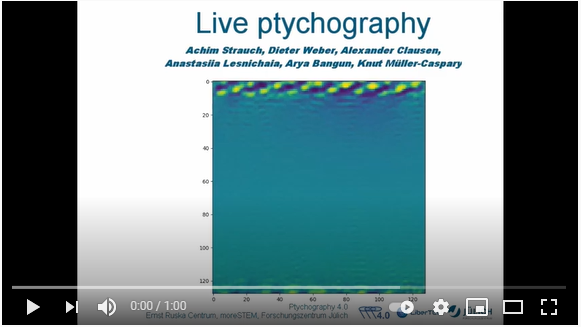LiberTEM is an open source platform for high-throughput distributed processing of electron microscopy datasets. Written primarily in Python, it is capable of processing live data streams, processing offline data interactively, and providing a computation engine for other libraries. The library allows a user to explore the vast, diverse landscape of interesting features which are revealed in electron microscope imagery.
Advanced analyses like ptychography, strain mapping or phase and orientation mapping require the acquisition and processing of large amounts of data. In the past this would take hours, but high-speed imaging detectors for electrons that became available from 2014 onwards created the potential to perform such analyses interactively in real time, as is already the case in conventional microscopy.
However, the software available at the time was fundamentally not capable of processing data at the rate these new detectors produced it. That's why we started the LiberTEM project: to leverage the full potential of high-speed imaging detectors in electron microscopy and other fields, and make it possible to apply advanced computational imaging techniques in real time. This opens the possibility to control microscopes with closed-loop feedback, and of course to process huge datasets that modern detectors can acquire, offline.
LiberTEM is split into several sub-projects: the processing engine, an
interactive web interface that is currently packaged with the processing
engine, live data processing infrastructure, several
application-specific packages, and spin-off packages with more general
application such as sparseconverter.
LiberTEM is an open source platform for high-throughput distributed processing of large-scale binary data sets and live data streams using a modified MapReduce programming model.
is an extension module for LiberTEM that allows live data processing.
is a package for correlation-based peak finding and strain mapping.
Off-axis electron holography (WIP)
Format detection, identifiers and converter matrix for a range of numerical array formats, focusing on sparse arrays.
Tools to calibrate a microscope
Implementations for ptychography that result from the work of the Ptychography 4.0 project. Most notably, this includes an implementation for Single Side Band ptychography that can process live data streams.
- Phase contrast
- Amorphous materials
- Strain mapping
- Phase change materials
- Off-axis electron holography
- Download a sample dataset
- Install LiberTEM and run the web GUI
- Download examples for Python API usage
- Install LiberTEM-live for live data processing and see example usage
To help us spread the word, please credit and cite LiberTEM in publications where it has been significant. Resources for citing LiberTEM are linked through the links or DOI badges below.
- LiberTEM: Software platform for scalable multidimensional data processing in transmission electron microscopy
- LiberTEM
- LiberTEM-live
- LiberTEM-blobfinder
- Live processing of momentum-resolved STEM data for first moment imaging and ptychography
- Next-Generation Information Technology Systems for Fast Detectors in Electron Microscopy
- Wigner Distribution Deconvolution Adaptation for Live Ptychography Reconstruction
See Acknowledgements!
<style> .libertem-ack-item { display: flex; } .libertem-ack-item img { display: block; } .libertem-ack-item > a { flex-shrink: 0; display: block; padding-right: 20px; } </style>LiberTEM kindly acknowledges funding and support from the following sources:

This project has received funding from the European Research Council (ERC) under the European Union’s Horizon 2020 research and innovation programme grant agreement No 780487.

This project has received funding from the European Union's Horizon 2020 research and innovation programme under grant agreement No 686053.

This project has received funding from the European Union's Horizon 2020 research and innovation programme under grant agreement No 823717.

This project has received funding from the European Research Council (ERC) under the European Union’s Horizon 2020 research and innovation programme ( grant agreement No 856538).

We gratefully acknowledge funding from the Initiative and Networking Fund of the Helmholtz Association within the Helmholtz Young Investigator Group moreSTEM under Contract No. VH-NG-1317 at Forschungszentrum Jülich in Germany.

We gratefully acknowledge funding from the Information & Data Science Pilot Project "Ptychography 4.0" of the Helmholtz Association.
We kindly acknowledge funding from Google Summer of Code 2019 and 2020 under the umbrella of the Python software foundation.

LiberTEM development is supported by AIDAS

LiberTEM development is part of the Joint Lab MDMC.

Forschungszentrum Jülich is supporting LiberTEM with funding for personnel, access to its infrastructure and administrative support.

STEMx equipment and software for 4D STEM data acquisition with K2 IS camera courtesy of Gatan Inc.

We thank Quantum Detectors for their help in implementing support for their cameras and file formats.

We thank DECTRIS for their help in implementing support for their cameras and file formats, outreach, and for providing access to prototypes.

We thank Amsterdam Scientific Instruments for their help in implementing support for their cameras and file formats, co-developing practical 4D STEM support with event-based detectors, outreach, and for providing access to prototypes.
- Gitter chat
- Dieter Weber d.weber@fz-juelich.de
- Alexander Clausen a.clausen@fz-juelich.de
- Matthew Bryan matthew.bryan@cea.fr
- GitHub issue trackers, see repo links above!
We thank all of our authors and contributors!













